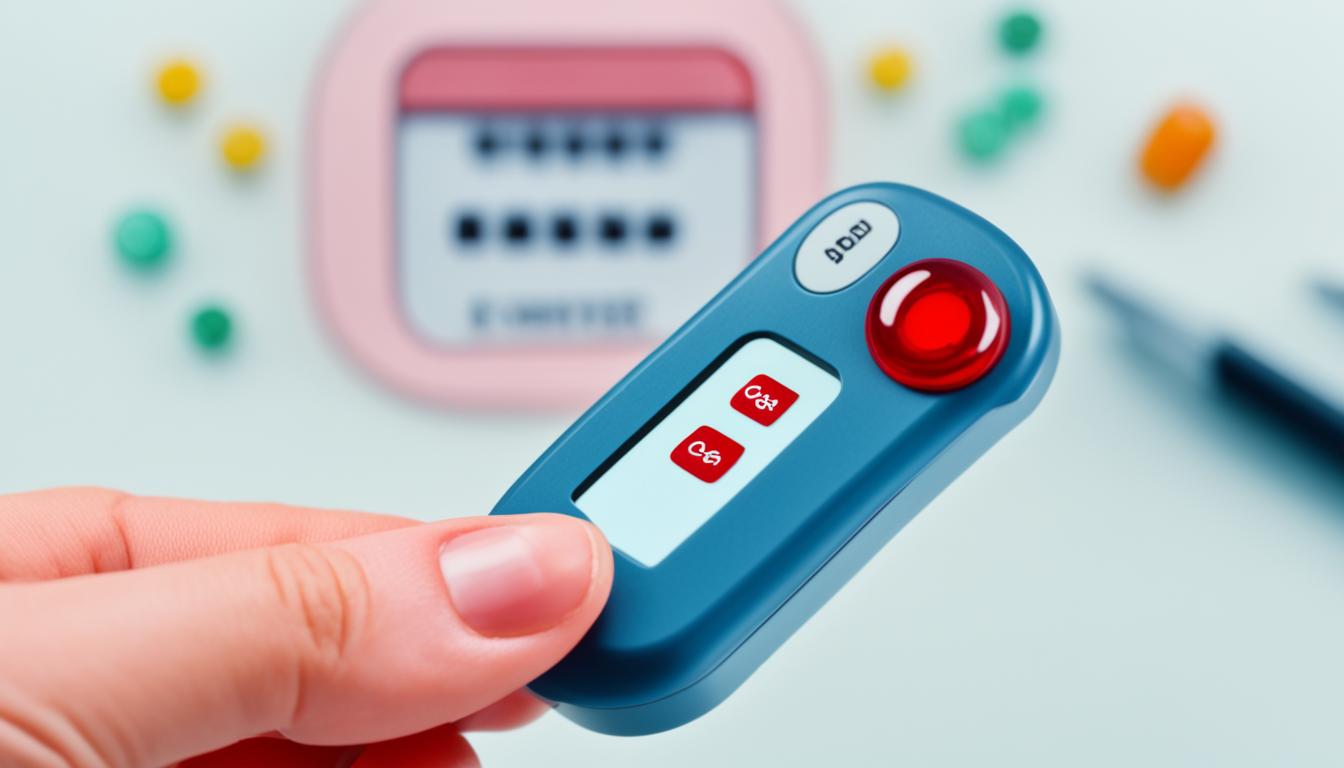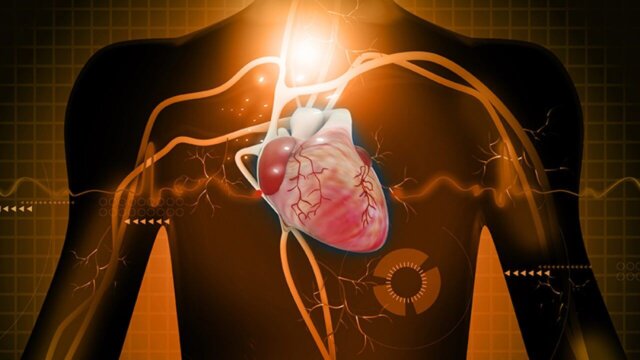FTC disclaimer: This post may contains affiliate links and we will be compensated if you click on a link and make a purchase.
About 1 in 10 people in the U.S. have diabetes. This shows how common high blood sugar is. It’s vital to know about its causes, signs, diagnosis, and treatment. High blood sugar, or hyperglycemia, means your blood has too much glucose. If not treated, it can cause serious health issues.
This article will cover everything you need to know about high blood sugar. We aim to give you the info to handle this important health issue well.
Key Takeaways
- High blood sugar, or hyperglycemia, is a common problem for people with diabetes, both type 1 and type 2.
- Hyperglycemia can lead to serious health problems if left untreated, including damage to blood vessels, nerves, and organs.
- Causes of hyperglycemia can include insulin resistance, pancreas issues, and temporary factors like stress or medications.
- Early symptoms of hyperglycemia include increased thirst, frequent urination, and blurred vision.
- Proper management of high blood sugar involves insulin usage, diet, exercise, and regular monitoring.
Many people with diabetes, diagnosed or not, face hyperglycemia. It’s key to know the causes, signs, and how to get help. This way, you can manage high blood sugar and avoid complications.
What Is High Blood Sugar (Hyperglycemia)?
Hyperglycemia means your blood sugar is too high. It happens when your body can’t use or make insulin right. Insulin helps control blood sugar levels. There are many reasons for it, like not using insulin well, problems with the pancreas, or stress and sickness.
Signs and Symptoms of Hyperglycemia
Early signs of high blood sugar are feeling very thirsty, needing to pee a lot, blurry vision, and headaches. If it’s not treated, it can get worse. You might feel tired, lose weight, and cuts and infections won’t heal well.
Causes of Hyperglycemia
Mostly, high blood sugar is from not using insulin well or problems with the pancreas. Stress, being sick, or eating too much can also raise your blood sugar.
High blood sugar is when your blood sugar is over 125 mg/dL while fasting or over 180 mg/dL 2 hours after eating. If your blood sugar is between 100 and 124 mg/dL while fasting, you might have pre-diabetes. If it’s over 125 mg/dL while fasting, you’re diabetic.
More people are getting high blood sugar because of being overweight, not moving enough, and getting older. The Centers for Disease Control and Prevention say nearly 30.5 million Americans have diabetes. About 84 million Americans have pre-diabetes.
“Hyperglycemia can be a serious and life-threatening condition if left untreated, but with proper management and care, it can be effectively controlled.”
Target Blood Sugar Levels
Keeping blood sugar levels healthy is key to avoiding hyperglycemia’s bad effects. The American Diabetes Association says to aim for 80 to 130 mg/dL before meals and less than 180 mg/dL 2 hours after eating if you have diabetes. For those without diabetes, fasting levels should be under 99 mg/dL.
For older adults or those with other health issues, targets might be a bit higher, around 100-140 mg/dL before meals. Keeping an eye on your blood sugar and staying within these ranges can stop insulin resistance, type 2 diabetes, and other problems.
Blood Sugar Levels | Target Ranges |
|---|---|
Before a meal (Fasting) | 80 to 130 mg/dL |
2 hours after a meal | Less than 180 mg/dL |
Low blood sugar (Hypoglycemia) | Below 70 mg/dL |
Remember, these are basic guidelines. Your healthcare provider might suggest different targets based on your health and needs. Checking your blood sugar often and working with your healthcare team can help you manage it well. This can prevent hyperglycemia’s bad effects.
Keeping your blood sugar in check is vital for your health. Knowing your target levels and managing them can help you take charge of your blood sugar management. This can lead to better health now and in the future.
Monitoring Blood Sugar Levels
Checking your blood sugar often is key to managing high blood sugar. You can use a glucose meter with test strips or a continuous glucose monitor (CGM). Glucose meters give you blood sugar levels right away with a finger stick. CGMs track your sugar levels all day, showing how they change. It’s important to check your CGM with finger sticks sometimes to make sure it’s right.
Home Blood Sugar Monitoring
Choosing how to check your blood sugar depends on many things. CGMs put a sensor under your skin to measure glucose in fluids. They can alert you if your sugar is too low or high. Using these devices lets you keep track of your sugar and share it with doctors to manage your diabetes better.
Hemoglobin A1C Test
An A1C test by your doctor shows your average blood sugar over 2-3 months. The American Diabetes Association wants most adults to aim for an A1C under 7%. This is like saying your average blood sugar should be under 154 mg/dL. Keeping an eye on your A1C and working with your healthcare team helps you keep your blood sugar healthy.
“Regular monitoring of blood glucose levels is crucial for individuals on insulin, pregnant women, those struggling to reach blood glucose targets, experiencing hypoglycemia, lacking typical warning signs for low blood glucose, or having ketones due to high blood glucose levels.”
Symptoms of Hyperglycemia
Hyperglycemia, or high blood sugar, shows in many ways, from mild to severe. The first signs are often small but can get worse if not treated.
Early Signs and Symptoms
Early signs include feeling very thirsty and needing to pee a lot. Your body is trying to get rid of the extra sugar. You might also see blurry vision and have headaches. These signs mean your blood sugar is too high, between 60 to 140 mg/dl.
Later Signs and Symptoms
High blood sugar for a long time makes you feel very tired and you might lose weight without trying. Your skin may heal slowly from cuts and get more infections. If not treated, it can lead to a serious condition called diabetic ketoacidosis (DKA).
DKA causes nausea, vomiting, stomach pain, and confusion. Long-term, high blood sugar can harm your nerves, eyes, and increase the risk of eye problems. It’s important to check your blood sugar often and work with your doctor to keep it under control.
Hyperglycemia symptoms can be different for everyone. It’s key to watch for any health changes. Catching the signs early and getting help can stop serious problems.
When to Seek Medical Attention
If you have severe hyperglycemia symptoms, get medical help fast. Signs like vomiting, stomach pain, confusion, or trouble breathing mean you might have a serious condition. This condition, called diabetic ketoacidosis, needs quick action.
Also, if your blood sugar is over 240 mg/dL (13.3 mmol/L) and you have ketones in your urine, call your doctor right away. High levels of blood sugar can lead to diabetic ketoacidosis.
Know the signs of high blood sugar and get medical help when you need it. Ignoring these signs can cause serious problems. So, don’t delay in getting the help you need.
“Seeking medical attention for high blood sugar is crucial, as it can prevent life-threatening complications.”
Your healthcare provider is there to help you manage your blood sugar. Don’t wait for an emergency to act. By being careful and getting medical care when needed, you can control your hyperglycemia and avoid serious issues.
Causes of High Blood Sugar
High blood sugar, also known as hyperglycemia, has many causes. It’s important to know what causes it to manage and prevent it.
Insulin Resistance
Insulin resistance is a big reason for high blood sugar. It happens when the body’s cells don’t react right to insulin. This hormone helps control blood sugar levels. This issue is a key part of type 2 diabetes and can keep blood glucose too high.
Pancreas Issues
Problems with the pancreas can also cause high blood sugar. This organ makes insulin. Diseases like pancreatitis or cancer can hurt its ability to make insulin. This makes blood sugar go up.
Temporary Causes
Some things can make blood sugar go up for a short time. Being sick, stressed, on certain medicines, or not drinking enough water can do it.
Knowing why blood sugar gets high helps in managing it. Working with a doctor can help find out why and how to keep it healthy.
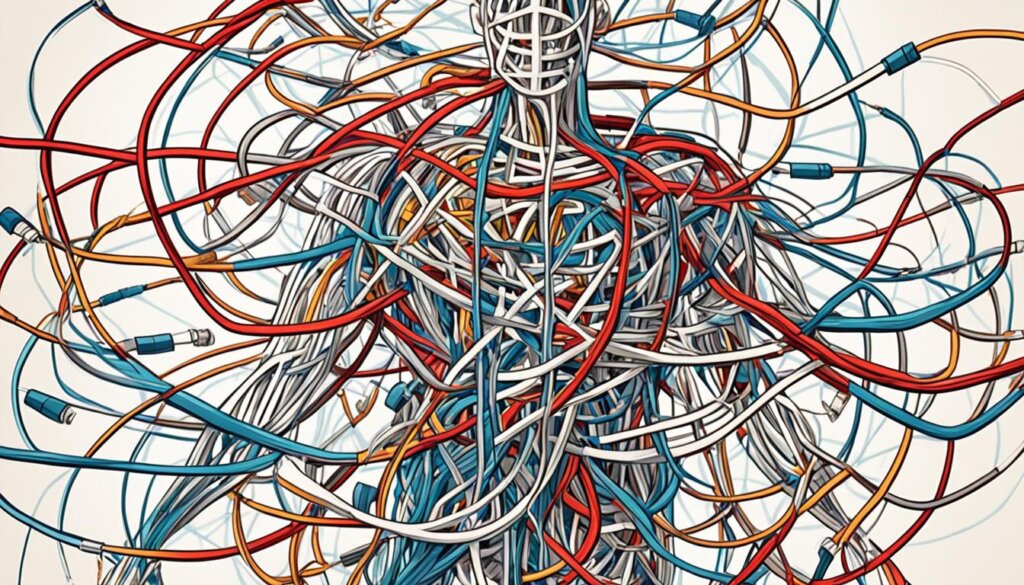
“Addressing the underlying causes of hyperglycemia is essential for effective blood sugar management and overall health.”
Complications of Untreated Hyperglycemia
Not controlling high blood sugar can lead to serious problems. These can affect your vision, circulation, and even your vital organs. It can also harm your overall health.
Long-Term Complications
High blood sugar over time can damage your body. This can cause serious health issues. Some of these problems include:
- Eye problems (retinopathy) that can lead to vision loss if left untreated
- Nerve damage (neuropathy) that can impact sensation and movement
- Kidney damage (nephropathy) that can impair fluid and waste processing
- Cardiovascular disease, including an increased risk of heart attacks and strokes
- Diabetic foot problems, such as sores and infections that can result in amputation
- Gum disease and oral health issues
- Sexual dysfunction, particularly in men
- A higher risk of certain types of cancer
Emergency Complications
High blood sugar can cause serious emergencies. These include:
- Diabetic ketoacidosis (DKA), a condition where the body produces toxic acids called ketones
- Hyperosmolar hyperglycemic state (HHS), a severe complication characterized by extremely high blood sugar levels
DKA and HHS need quick medical help. This is to prevent coma or death.
Keeping your blood sugar, blood pressure, and blood fats in check can lower the risk of diabetes problems. Eating right, staying active, and quitting smoking helps too. Regular doctor visits and watching your diabetes are key to catching problems early.
Complication | Description | Impact |
|---|---|---|
Eye problems (retinopathy) | Damage to the blood vessels in the eyes | Potential vision loss if left untreated |
Nerve damage (neuropathy) | Impaired nerve function | Pain, burning, tingling, and erectile dysfunction |
Kidney damage (nephropathy) | Impaired kidney function | Potential need for dialysis or kidney transplant |
Cardiovascular disease | Increased risk of heart attacks and strokes | Impact on overall heart and vascular health |
Diabetic foot problems | Sores, infections, and potential amputation | Limb loss and mobility issues |
Knowing the risks of not controlling high blood sugar helps you act early. This can lower the chance of serious health problems.
Preventing High Blood Sugar
Keeping blood sugar levels healthy is key for people with diabetes or prediabetes. To stop high blood sugar, we need a plan. Losing a bit of weight is a great way to lower diabetes risk. For example, losing about 7% of your weight can cut diabetes risk by almost 60%.
The American Diabetes Association says people with prediabetes should lose 7% to 10% of their weight. Losing more weight can bring even more benefits. Adults should do at least 150 minutes of moderate to vigorous exercise each week. They should also do resistance training 2 to 3 times a week to get stronger and stay active.
What we eat is very important for keeping blood sugar low. Foods high in fiber slow down sugar absorption and lower blood sugar. Healthy fats help keep blood cholesterol levels good and support heart health. Keeping a healthy weight is key to preventing diabetes.
It’s important to get checked for type 2 diabetes if you’re 45 or older, or if you’re overweight and have other risk factors. This includes women who have gestational diabetes, people with prediabetes, and kids who are overweight and have a family history of diabetes.
By managing weight, staying active, eating well, and getting regular check-ups, we can prevent high blood sugar and diabetes. The Centers for Disease Control and Prevention say 13% of Americans and 25% of those 65 or older have high blood sugar. Drinking enough water, eating minerals like chromium and magnesium, and sleeping well can also help control blood sugar and prevent high levels.

To prevent high blood sugar, we need to change our lifestyle, eat better, and keep an eye on our health. By acting early, people with diabetes or at risk can manage their blood sugar better and avoid serious health problems.
Managing High Blood Sugar
Managing high blood sugar needs a mix of diet, exercise, and medicine. By eating right, moving more, and taking your medicine, you can control your blood sugar. This helps lower the risk of serious health problems.
Diet and Exercise
Eating right is key to managing high blood sugar. Eat foods high in fiber like whole grains, fruits, and veggies. These foods help keep your glucose levels stable. Try to eat fewer refined carbs and choose foods with a low glycemic index to avoid blood sugar spikes. Drinking plenty of water also helps prevent high blood sugar.
Exercise is also vital for controlling high blood sugar. Aim for 150 minutes of moderate exercise each week, like walking, swimming, or biking. Even simple activities like cleaning or gardening can help manage your blood sugar.
Medication Adherence
Using your diabetes medicine as told is key to keeping your blood sugar in check. Don’t skip any doses to make sure it works well. Also, store and handle your medicine right, and check your blood sugar when you’re sick.
Handling high blood sugar means changing your diet, moving more, and taking your medicine. These changes help you control your blood sugar and lower the risk of serious problems.
Risk Factors for Hyperglycemia
Keeping blood sugar levels healthy is key. Many things can make you more likely to have high blood sugar or hyperglycemia. People with type 1 or type 2 diabetes are at high risk, especially if they don’t manage their condition well. Being overweight, not moving much, and eating a lot of processed carbs can also lead to high blood sugar.
Some medicines, hormonal issues like Cushing’s syndrome, and stress from being sick, hurt, or upset can make blood sugar go up. This is true even for people who don’t have diabetes. Checking your blood sugar often and following a good care plan are key to handling high blood sugar and avoiding serious problems.
Risk Factor | Description |
|---|---|
Type 1 or Type 2 Diabetes | People with diabetes face a higher chance of high blood sugar, especially if it’s not well managed. |
Obesity | Being overweight can make it harder for your body to control blood sugar levels. |
Sedentary Lifestyle | Not moving much can make it tough for your body to keep blood sugar in check. |
High-Carb Diet | Eating a lot of processed carbs can cause blood sugar to go up and increase the risk of high blood sugar. |
Certain Medications | Some medicines, like corticosteroids, can make blood sugar levels go up. |
Hormonal Imbalances | Conditions like Cushing’s syndrome, which affects hormones, can lead to high blood sugar. |
Acute Stress | Being sick, hurt, or stressed can cause a temporary increase in blood sugar levels. |
Knowing about risk factors for high blood sugar helps you take steps to watch your diabetes risk factors and stop hyperglycemia triggers. Regular doctor visits, managing any health issues, and changing your lifestyle can keep your blood sugar healthy. This can lower the chance of problems from high blood sugar.
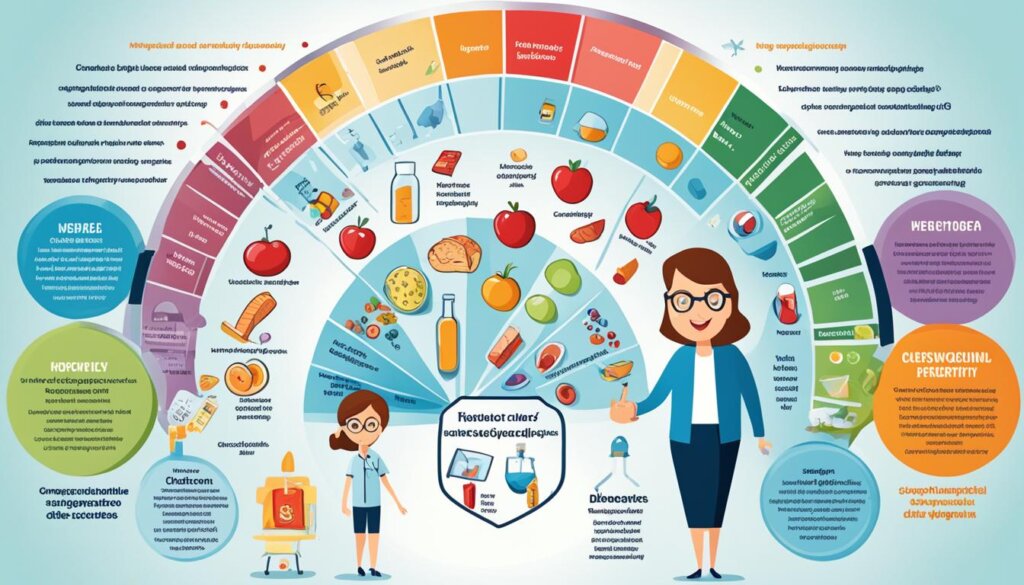
“Consistent monitoring and effective management of hyperglycemia are essential in preventing long-term health consequences.”
Diagnosis of High Blood Sugar
Diagnosing high blood sugar is key to managing diabetes. Doctors use blood tests to check for high blood sugar levels.
Blood Glucose Tests
The random or fasting blood glucose test checks sugar levels at a certain time. The A1C test shows average blood sugar over 2-3 months.
An A1C level of 6.5% or higher on two tests means diabetes. Levels between 5.7% and 6.4% mean prediabetes. Below 5.7% is normal.
A random test of 200 mg/dL or higher points to diabetes. Fasting levels of 100 to 125 mg/dL are prediabetes. 126 mg/dL or higher on two tests means diabetes.
Additional Diagnostic Tests
Some tests, like the oral glucose tolerance test, may be ordered. It checks blood sugar before and after a sugary drink. A level over 200 mg/dL after two hours means diabetes. 140 to 199 mg/dL is prediabetes.
For type 1 diabetes, continuous glucose monitoring checks treatment success. The aim is to keep glucose levels between 70 and 180 mg/dL most of the time.
If high blood sugar is found, more tests may be done. This is to find the cause, like insulin resistance or pancreatic issues.
Treatment Options for Hyperglycemia
Managing high blood sugar, or hyperglycemia, needs a full plan. This plan includes insulin therapy, diabetes pills, and changing your lifestyle. For type 1 diabetes, insulin is key to keeping blood sugar right. Type 2 diabetes patients might use insulin, metformin, and other pills to make their bodies better at using insulin and controlling sugar.
Insulin Therapy
Some people with type 2 diabetes need insulin if diet and pills don’t control their blood sugar. There are different types of insulin, like long-acting and short-acting, to help manage sugar levels.
Oral Medications
Metformin is often the first pill given to type 2 diabetes patients. It helps lower sugar in the liver and makes the body more sensitive to insulin. Other pills, like sulfonylureas and DPP-4 inhibitors, can also be used. Each has its own effects and benefits.
Lifestyle Modifications
Changing what you eat, moving more, and managing your weight can help lower blood sugar and prevent problems. Losing just 5% of your weight can make a big difference for people with type 2 diabetes. Adults with type 2 diabetes should try to exercise for at least 30 minutes a day or 150 minutes a week. They should also do resistance exercises 2 to 3 times a week.
Creating a treatment plan that fits you is crucial for managing high blood sugar and avoiding long-term problems. Working with your healthcare team can help you find the best way to keep your blood sugar in check and improve your health.
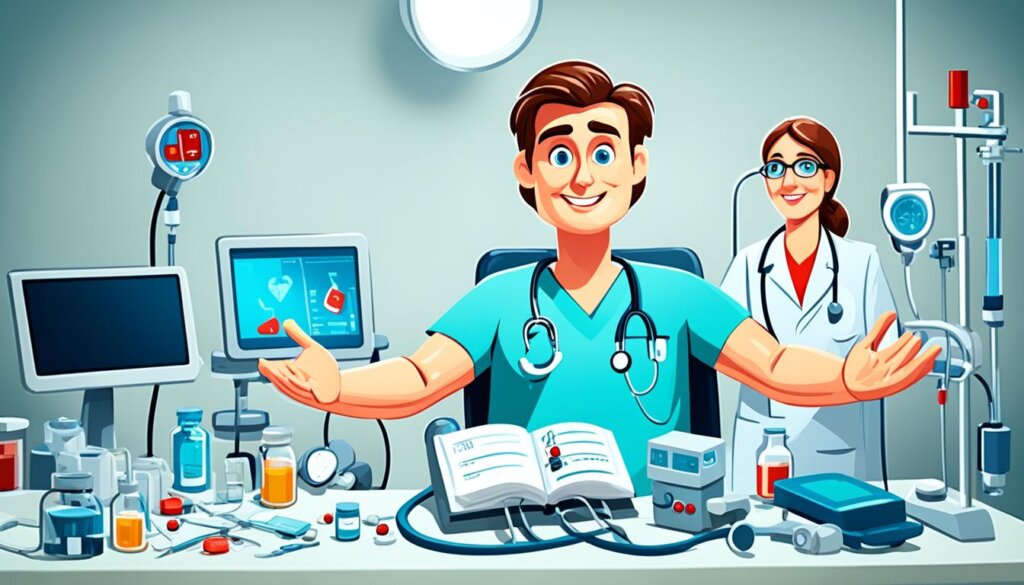
“Keeping your blood sugar healthy is key to avoiding the bad effects of high blood sugar. A plan that includes insulin, pills, and lifestyle changes can help people with diabetes reach their goals.”
Conclusion
High blood sugar, or hyperglycemia, is a serious condition that needs quick action to prevent serious problems. It’s important to know the causes, signs, and risk factors for those with diabetes or at risk. Keeping an eye on your blood sugar, following a good diabetes plan, and working with your healthcare team help manage high blood sugar and lower risks.
Keeping your blood sugar in check is key. Long-term high blood sugar can harm your kidneys, brain, heart, and eyes. It also makes you more likely to get sick, so managing your blood sugar helps keep your immune system strong.
Being proactive in managing high blood sugar helps you take charge of your health. Success comes from living a healthy life, sticking to your treatment, and working with your healthcare team to keep your blood sugar in check. With the right steps and support, you can handle hyperglycemia and lower the risk of long-term problems.
FAQ
What is high blood sugar (hyperglycemia)?
High blood sugar, or hyperglycemia, means your blood has too much glucose. It’s common in people with diabetes, like type 1 and type 2.
What are the signs and symptoms of hyperglycemia?
Early signs include feeling thirsty and needing to pee a lot, blurry vision, and headaches. If not treated, it can cause more serious issues like feeling tired, losing weight, and cuts and infections that don’t heal well.
What causes high blood sugar?
High blood sugar can come from insulin resistance, pancreas problems, or short-term issues like stress and illness. Insulin resistance, where cells don’t react to insulin, is a big reason for type 2 diabetes and high blood sugar.
What are the target blood sugar levels?
Doctors set specific blood sugar goals for people with diabetes. For adults under 60 with no other health issues, these goals are 80-120 mg/dL before meals and under 180 mg/dL two hours after eating.
How do I monitor my blood sugar levels?
Checking your blood sugar regularly is key to managing high levels. People with diabetes can use a portable meter at home. The American Diabetes Association suggests checking before meals and two hours after meals start.
When should I seek medical attention for high blood sugar?
Call your doctor right away if you have severe symptoms like vomiting, stomach pain, confusion, or trouble breathing. These could mean diabetic ketoacidosis, a serious condition needing quick treatment.
What are the long-term complications of untreated hyperglycemia?
Not treating high blood sugar can lead to serious problems. Over time, it can harm blood vessels and nerves, causing heart disease, nerve damage, kidney problems, and vision loss.
How can I prevent high blood sugar?
To prevent high blood sugar, follow a diabetes meal plan, take your medicines as directed, and check your blood sugar often. Being active and managing stress can also help keep your blood sugar healthy.
How is high blood sugar treated?
Treating high blood sugar includes insulin therapy, diabetes pills, and making lifestyle changes. Eating right, staying active, and managing your weight can also help lower blood sugar and prevent complications.
What are the risk factors for developing hyperglycemia?
Being overweight, not moving much, eating too many processed carbs, certain medicines, and hormonal issues like Cushing’s syndrome can raise your risk. People with type 1 or type 2 diabetes are especially at risk if their diabetes isn’t well-controlled.
